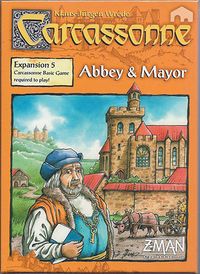Abbey and the Mayor (1st edition)
General info and comments
Abbey and the Mayor (Major Expansion #5) was originally released by Hans im Glück in 2007
Contents
- 12 new and tiles
- 6 abbey tiles
- 6 barns
- 6 wagons
- 6 mayors
A series of remarks on some features present in the tiles of this expansion:
Rules
Preparation
At the beginning of the game, every player receives one abbey tile and one mayor, one barn, and one wagon of the player's chosen color, and places these in his or her supply.[1] With the exception of the following changes, the basic rules for Carcassonne remain unchanged.
Playing the Game
1. Place a tile
The new land tiles are placed in the usual way. [2] [3] [4]
The abbey
Instead of drawing and placing a land tile, a player may instead choose to place his or her abbey tile. [5] The abbey may be placed anywhere that precisely one land tile fits: that is, it can only be placed in a 'hole' in which all four sides are already bordered by land tiles. [6] [7] If there is no such 'hole' available, the abbey cannot be placed.
If one or more players have not placed their Abbey when the last landscape tile is drawn and placed, they may still do so, in clockwise order starting from the left of the person who placed the last tile, as long as it is in accordance with the rules. The game is then over. [8] [9]
Tile distribution
Total Tiles: 12
Footnotes
For Icons explanation and licensing please visit Icons page.
- ↑ Official status: The mayor and wagon are followers, subject to the usual rules of deployment and affecting the majority. The barn is a special figure, not a follower.
- ↑ In the case of the tile with the well and three roads, all of the roads have to be completed before scoring.
- ↑ With the three-way tile in Abbey and the Mayor, the length of the road (e.g. for the purposes of the Robber Baron) is the total number of tiles in the road, not simply the longest distance between two ends. The road has three ends which have to be closed, but the result is that it’s likely to be bigger.
- ↑ In the examples for this expansion, the road with a tunnel does indeed count as being “broken” if one is using The Tunnel expansion, in which case the tile contains two as yet unconnected tunnel openings.
- ↑ If a player has an abbey left, draws the very last tile, and plays it to a feature where he or she has a builder, the abbey may be played on the second part of the double-turn (i.e. before the final round of abbey placement).
- ↑ The RGG edition clarifies this sentence by adding "(not the diagonals)".
- ↑ The rules that restrict the placement of cloisters next to already placed shrines also restrict the placement of abbeys.
- ↑ This paragraph was added in HiG’s and RGG’s Big Box 2, and actually contradicts an earlier FAQ (which stated that the abbey tiles couldn’t be placed once the last landscape tile was drawn).
- ↑ When an abbey is played in this manner, a follower may be deployed to the abbey as usual. If the abbey is completely surrounded and thus immediately finished, the abbey is scored as in a normal turn. Then final scoring occurs. (5/2013)
